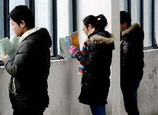
China set the yuan's central parity rate against the U.S. dollar at 6.2855 on the last trading day of 2012, up 154 basis points from the same day of the previous year. The Chinese yuan appreciated 0.25 percent against the U.S. dollar last year, with two-way fluctuations and increasing flexibility.
Experts believe that the yuan's exchange rate will maintain its moderate upward trend this year, but the room for further yuan appreciation will be limited despite increasing flexibility, given the macroeconomic situation and policy tone.
Two-way fluctuations hit new high
The yuan's exchange rate against the U.S. dollar fluctuated sharply last year, and went through three stages – narrow fluctuations, depreciation, and appreciation. Two-way fluctuations hit a new high since the launch of the exchange rate reform, and appreciation expectations alternated with depreciation expectations.
The yuan performed poorly against the U.S. dollar in the first half of last year, but started appreciating at a markedly faster pace since July. The yuan's spot exchange rate against the U.S. dollar hit the upper limit of its 1 percent daily trading band for 20 out of 22 trading days in November.
The yuan appreciated about 5 percent annually against the U.S. dollar since the launch of the exchange rate reform in 2005, and the rise in its exchange rate against the dollar in 2012 was relatively small.
Lian Ping, chief economist at the Bank of Communications, said that the changes in market expectations and related policies contributed to yuan appreciation.
As China's economy stabilized and bottomed out, trade surplus expanded, and consumer prices passed the inflection point, the expectations of yuan depreciation dropped. At the same time, the U.S. policy of quantitative easing increased the expectations of dollar depreciation.
Given the international political pressure for yuan appreciation, the People's Bank of China, the country's central bank, lowered the yuan's central parity rate against the U.S. dollar in mid-September so as to revalue the yuan. Due to market and policy factors, domestic companies and residents became more willing to settle foreign exchange and less willing to sell foreign exchange, which contributed to yuan appreciation.
Internationally speaking, the new round of quantitative easing also contributed to yuan appreciation. International capital flows to emerging market economies in the Asia-Pacific region also increased the yuan appreciation pressure, said Wen Bin, director of the Institute of International Finance under the Bank of China.

Read the Chinese version: 人民币汇率今年不会大幅升值














 Spring Festival draws near, immigrant workers have begun to go home, leading a travel peak at the railway station.
Spring Festival draws near, immigrant workers have begun to go home, leading a travel peak at the railway station.


![]()
